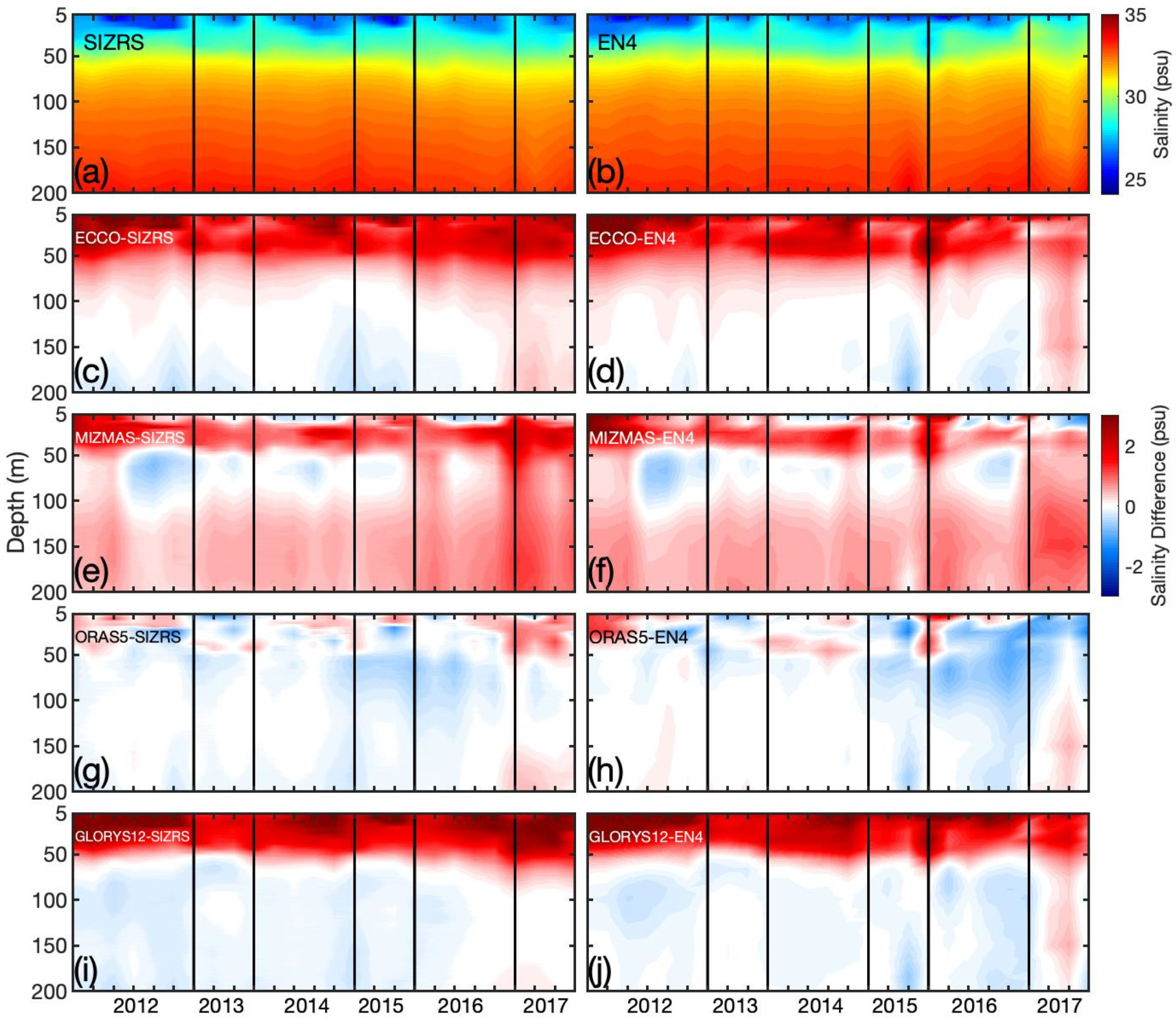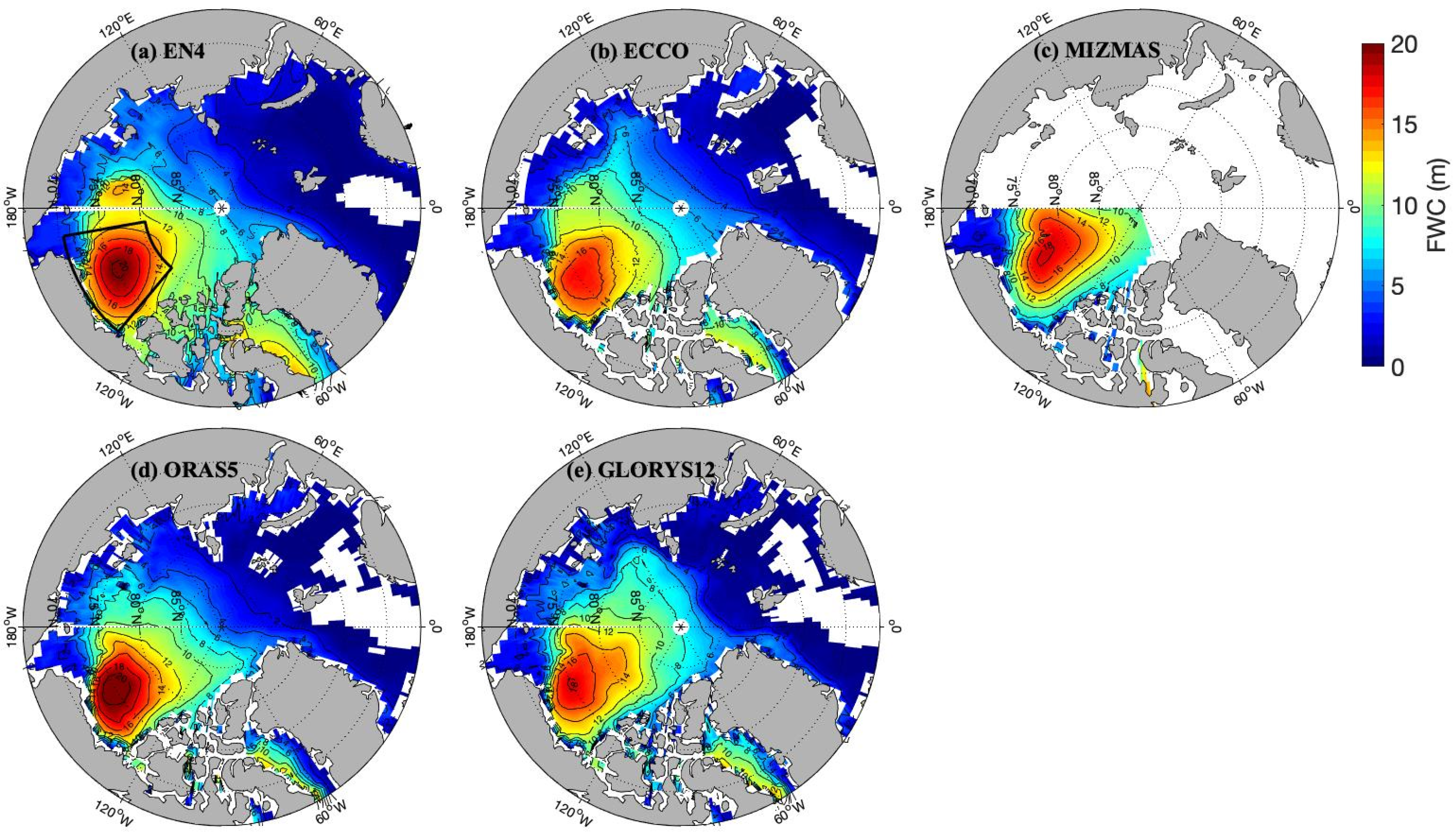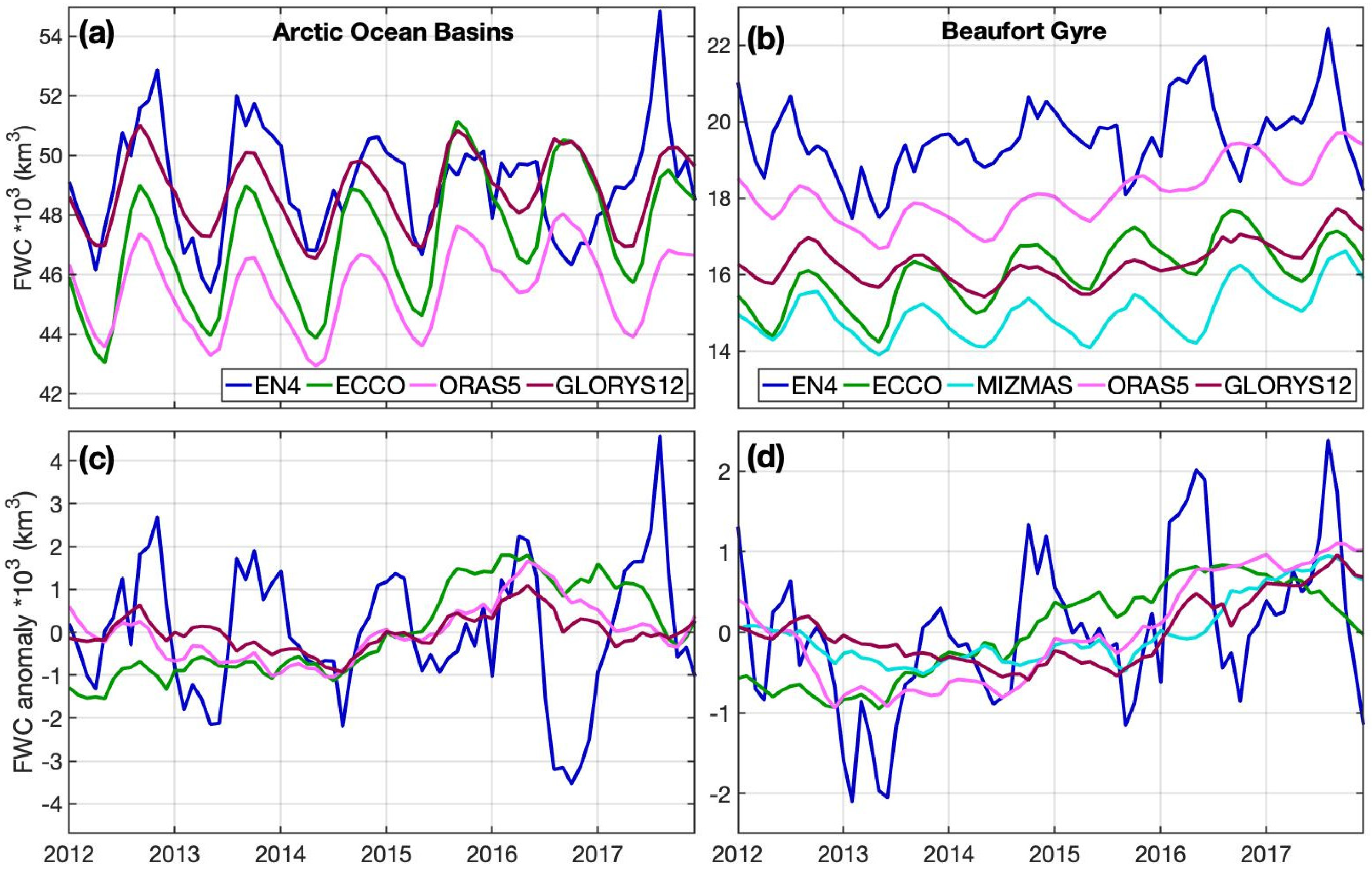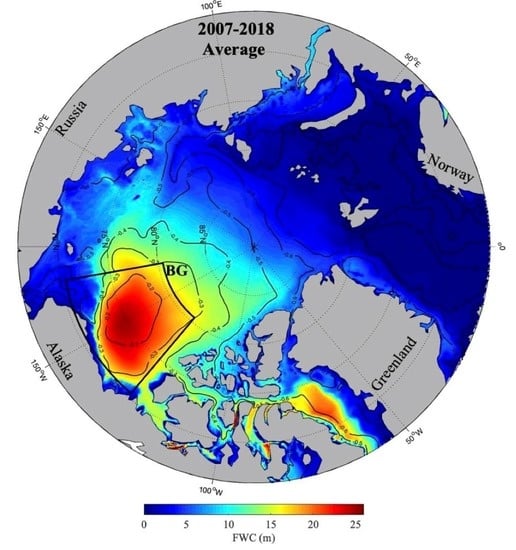Intercomparison of Salinity Products in the Beaufort Gyre and Arctic Ocean
Abstract
:1. Introduction
2. Observations and Models
2.1. Observations
2.1.1. Satellite Data
2.1.2. In Situ Measurements
2.2. Ocean Model Simulations and Reanalysis Products
3. Results
3.1. Sea Surface Salinity
3.2. Vertical Salinity Structure
3.3. Freshwater Content
4. Discussion
4.1. Sea Surface Salinity
4.2. Vertical Salinity Structure
4.3. Freshwater Content
5. Conclusions
Author Contributions
Funding
Institutional Review Board Statement
Informed Consent Statement
Data Availability Statement
Acknowledgments
Conflicts of Interest
References
- Fournier, S.; Lee, T.; Wang, X.; Armitage, T.W.K.; Wang, O.; Fukumori, I.; Kwok, R. Sea Surface Salinity as a Proxy for Arctic Ocean Freshwater Changes. J. Geophys. Res. Oceans 2020, 125, e2020JC016110. [Google Scholar] [CrossRef]
- Krishfield, R.A.; Proshutinsky, A.; Tateyama, K.; Williams, W.J.; Carmack, E.C.; McLaughlin, F.A.; Timmermans, M.-L. Deterioration of perennial sea ice in the Beaufort Gyre from 2003 to 2012 and its impact on the oceanic freshwater cycle. J. Geophys. Res. Oceans 2014, 119, 1271–1305. [Google Scholar] [CrossRef]
- Proshutinsky, A.; Johnson, M.A. Two circulation regimes of the wind-driven Arctic Ocean. J. Geophys. Res. Space Phys. 1997, 102, 12493–12514. [Google Scholar] [CrossRef]
- Proshutinsky, A.; Krishfield, R.; Timmermans, M.-L.; Toole, J.; Carmack, E.; McLaughlin, F.; Williams, W.J.; Zimmermann, S.; Itoh, M.; Shimada, K. Beaufort Gyre freshwater reservoir: State and variability from observations. J. Geophys. Res. Space Phys. 2009, 114, C00A10. [Google Scholar] [CrossRef]
- Morison, J.; Kwok, R.; Dickinson, S.; Andersen, R.; Peralta-Ferriz, C.; Morison, D.; Rigor, I.; Dewey, S.; Guthrie, J. The Cyclonic Mode of Arctic Ocean Circulation. J. Phys. Oceanogr. 2021, 51, 1053–1075. [Google Scholar] [CrossRef]
- Morison, J.; Kwok, R.; Peralta-Ferriz, C.; Alkire, M.; Rigor, I.; Andersen, R.; Steele, M. Changing Arctic Ocean freshwater pathways. Nat. Cell Biol. 2012, 481, 66–70. [Google Scholar] [CrossRef] [PubMed]
- Haine, T.W.N.; Curry, B.; Gerdes, R.; Hansen, E.; Karcher, M.; Lee, C.; Rudels, B.; Spreen, G.; de Steur, L.; Stewart, K.D.; et al. Arctic freshwater export: Status, mechanisms, and prospects. Glob. Planet. Chang. 2015, 125, 13–35. [Google Scholar] [CrossRef] [Green Version]
- De Steur, L.; Steele, M.; Hansen, E.; Morison, J.; Polyakov, I.; Olsen, S.M.; Melling, H.; McLaughlin, F.A.; Kwok, R.; Smethie, W.M.; et al. Hydrographic changes in the Lincoln Sea in the Arctic Ocean with focus on an upper ocean freshwater anomaly between 2007 and 2010. J. Geophys. Res. Oceans 2013, 118, 4699–4715. [Google Scholar] [CrossRef] [Green Version]
- Aagaard, K.; Carmack, E.C. The role of sea ice and other fresh water in the Arctic circulation. J. Geophys. Res. Space Phys. 1989, 94, 14485–14498. [Google Scholar] [CrossRef]
- Carmack, E.; McLaughlin, F.; Yamamoto-Kawai, M.; Itoh, M.; Shimada, K.; Krishfield, R.; Proshutinsky, A. Freshwater Storage in the Northern Ocean and the Special Role of the Beaufort Gyre; Springer: Singapore, 2008; pp. 145–169. [Google Scholar]
- Fuentes-Franco, R.; Koenigk, T. Sensitivity of the Arctic freshwater content and transport to model resolution. Clim. Dyn. 2019, 53, 1765–1781. [Google Scholar] [CrossRef] [Green Version]
- Dewey, S.R.; Morison, J.H.; Zhang, J. An Edge-Referenced Surface Fresh Layer in the Beaufort Sea Seasonal Ice Zone. J. Phys. Oceanogr. 2017, 47, 1125–1144. [Google Scholar] [CrossRef]
- Meissner, T.; Wentz, F.J.; Manaster, A.; Lindsley, R. Remote Sensing Systems SMAP Ocean Surface Salinities Level 3 Running 8-Day, Version 4.0 Validated Release. Remote Sensing Systems. Santa Rosa, CA, USA. Available online: www.remss.com/missions/smap/salinity/ (accessed on 3 April 2021).
- Meissner, T.; Wentz, F.J.; Le Vine, D.M. The Salinity Retrieval Algorithms for the NASA Aquarius Version 5 and SMAP Version 3 Releases. Remote Sens. 2018, 10, 1121. [Google Scholar] [CrossRef] [Green Version]
- Melnichenko, O.; Hacker, P.; Potemra, J.; Meissner, T.; Wentz, F. Aquarius/SMAP Sea Surface Salinity Optimum Interpolation Analysis. IPRC Technical Note No. 7. 2021. Available online: https://podaac-tools.jpl.nasa.gov/drive/files/allData/smap/docs/OISSS_V1/L4OISSS_MultimissionProductGuide_V1.pdf (accessed on 10 September 2021).
- Melnichenko, O.; Hacker, P.; Maximenko, N.; Lagerloef, G.; Potemra, J. Spatial Optimal Interpolation of Aquarius Sea Surface Salinity: Algorithms and Implementation in the North Atlantic*. J. Atmospheric Ocean. Technol. 2014, 31, 1583–1600. [Google Scholar] [CrossRef]
- Melnichenko, O.; Hacker, P.; Maximenko, N.; Lagerloef, G.; Potemra, J. Optimum interpolation analysis of A quarius sea surface salinity. J. Geophys. Res. Oceans 2016, 121, 602–616. [Google Scholar] [CrossRef] [Green Version]
- Good, S.A.; Martin, M.J.; Rayner, N.A. EN4: Quality controlled ocean temperature and salinity profiles and monthly objective analyses with uncertainty estimates. J. Geophys. Res. Oceans 2013, 118, 6704–6716. [Google Scholar] [CrossRef]
- Fukumori, I.; Wang, O.; Fenty, I.; Forget, G.; Heimbach, P.; Ponte, R.M. Synopsis of the ECCO Central Production Global Ocean and Sea-Ice State Estimate, Version 4 Release 4 (Version 4 Release 4). Zenodo. 2021. Available online: https://zenodo.org/record/4533349#.YcUpvlkRVPY (accessed on 22 February 2021).
- Forget, G.; Campin, J.-M.; Heimbach, P.; Hill, C.N.; Ponte, R.M.; Wunsch, C. ECCO version 4: An integrated framework for non-linear inverse modeling and global ocean state estimation. Geosci. Model Dev. 2015, 8, 3071–3104. [Google Scholar] [CrossRef] [Green Version]
- ECCO Consortium; Fukumori, I.; Wang, O.; Fenty, I.; Forget, G.; Heimbach, P.; Ponte, R.M. ECCO Central Estimate (Version 4 Release 4). Available online: https://ecco.jpl.nasa.gov/drive/ (accessed on 22 February 2021).
- Zhang, J.; Rothrock, D.A. Modeling Global Sea Ice with a Thickness and Enthalpy Distribution Model in General-ized Curvilinear Coordinates. Mon. Weather Rev. 2003, 131, 681–697. [Google Scholar] [CrossRef] [Green Version]
- Zhang, J.; Schweiger, A.; Steele, M. MIZMAS: Modeling the Evolution of Ice Thickness and Floe Size Distributions in the Marginal Ice Zone of the Chukchi and Beaufort Seas; Distribution Statement A; US Dept. of the Navy: Arlington, VA, USA, 2013.
- Kalnay, E.; Kanamitsu, M.; Kistler, R.; Collins, W.; Deaven, D.; Gandin, L.; Iredell, M.; Saha, S.; White, G.; Woollen, J.; et al. The NCEP/NCAR 40-Year Reanalysis Project. Bull. Am. Meteorol. Soc. 1996, 77, 437–472. [Google Scholar] [CrossRef] [Green Version]
- Zhang, J.; Steele, M.; Runciman, K.; Dewey, S.; Morison, J.; Lee, C.; Rainville, L.; Cole, S.; Krishfield, R.; Timmermans, M.-L.; et al. The Beaufort Gyre intensification and stabilization: A model-observation synthesis. J. Geophys. Res. Oceans 2016, 121, 7933–7952. [Google Scholar] [CrossRef] [Green Version]
- Hunke, E.C.; Lipscomb, W. CICE: The Los Alamos Sea Ice Model, Documentation and Software User’s Manual, Version 4.0; Technical Report LA-CC-06-012; Los Alamos National Laboratory: Los Alamos, NM, USA, 2008.
- Chassignet, E.P.; Hurlburt, H.E.; Metzger, E.J.; Smedstad, O.M.; Cummings, J.A.; Halliwell, G.R.; Bleck, R.; Baraille, R.; Wallcraft, A.J.; Lozano, C.; et al. US GODAE: Global Ocean Prediction with the HYbrid Coordinate Ocean Model (HYCOM). Oceanography 2009, 22, 64–75. [Google Scholar] [CrossRef]
- Zuo, H.; Balmaseda, M.A.; Tietsche, S.; Mogensen, K.; Mayer, M. The ECMWF operational ensemble reanalysis–analysis system for ocean and sea ice: A description of the system and assessment. Ocean Sci. 2019, 15, 779–808. [Google Scholar] [CrossRef] [Green Version]
- Dee, D.P.; Uppala, S.M.; Simmons, A.J.; Berrisford, P.; Poli, P.; Kobayashi, S.; Andrae, U.; Balmaseda, M.A.; Balsamo, G.; Bauer, P.; et al. The ERA-Interim reanalysis: Configuration and performance of the data assimilation system. Q. J. R. Meteorol. Soc. 2011, 137, 553–597. [Google Scholar] [CrossRef]
- Breivik, Ø.; Mogensen, K.; Bidlot, J.-R.; Balmaseda, M.A.; Janssen, P.A.E.M. Surface wave effects in the NEMO ocean model: Forced and coupled experiments. J. Geophys. Res. Oceans 2015, 120, 2973–2992. [Google Scholar] [CrossRef] [Green Version]
- Large, W.G.; Yeager, S.G. The global climatology of an interannually varying air–sea flux data set. Clim. Dyn. 2009, 33, 341–364. [Google Scholar] [CrossRef]
- Verezemskaya, P.; Barnier, B.; Gulev, S.K.; Gladyshev, S.; Molines, J.; Gladyshev, V.; Lellouche, J.; Gavrikov, A. Assessing Eddying (1/12°) Ocean Reanalysis GLORYS12 Using the 14-yr Instrumental Record From 59.5°N Section in the Atlantic. J. Geophys. Res. Oceans 2021, 126. [Google Scholar] [CrossRef]
- Boé, J.; Hall, A.; Qu, X. September sea-ice cover in the Arctic Ocean projected to vanish by 2100. Nat. Geosci. 2009, 2, 341–343. [Google Scholar] [CrossRef]
- Proshutinsky, A.; Krishfield, R.; Toole, J.M.; Timmermans, M.; Williams, W.; Zimmermann, S.; Yamamoto-Kawai, M.; Armitage, T.W.K.; Dukhovskoy, D.; Golubeva, E.; et al. Analysis of the Beaufort Gyre Freshwater Content in 2003–2018. J. Geophys. Res. Oceans 2019, 124, 9658–9689. [Google Scholar] [CrossRef] [PubMed] [Green Version]
- Xie, J.; Raj, R.P.; Bertino, L.; Samuelsen, A.; Wakamatsu, T. Evaluation of Arctic Ocean surface salinities from the Soil Moisture and Ocean Salinity (SMOS) mission against a regional reanalysis and in situ data. Ocean Sci. 2019, 15, 1191–1206. [Google Scholar] [CrossRef] [Green Version]
- Fournier, S.; Lee, T.; Tang, W.; Steele, M.; Olmedo, E. Evaluation and Intercomparison of SMOS, Aquarius, and SMAP Sea Surface Salinity Products in the Arctic Ocean. Remote Sens. 2019, 11, 3043. [Google Scholar] [CrossRef] [Green Version]
- Bao, S.; Wang, H.; Zhang, R.; Yan, H.; Chen, J. Comparison of Satellite-Derived Sea Surface Salinity Products from SMOS, Aquarius, and SMAP. J. Geophys. Res. Oceans 2019, 124, 1932–1944. [Google Scholar] [CrossRef]
- Bingham, F.; Brodnitz, S.; Yu, L. Sea Surface Salinity Seasonal Variability in the Tropics from Satellites, Gridded In Situ Products and Mooring Observations. Remote Sens. 2020, 13, 110. [Google Scholar] [CrossRef]
- Carton, J.A.; Penny, S.; Kalnay, E. Temperature and Salinity Variability in the SODA3, ECCO4r3, and ORAS5 Ocean Reanalyses, 1993–2015. J. Clim. 2019, 32, 2277–2293. [Google Scholar] [CrossRef]
- Zhang, J.; Woodgate, R.; Moritz, R. Sea Ice Response to Atmospheric and Oceanic Forcing in the Bering Sea. J. Phys. Oceanogr. 2010, 40, 1729–1747. [Google Scholar] [CrossRef]
- Peralta-Ferriz, C.; Woodgate, R.A. Seasonal and interannual variability of pan-Arctic surface mixed layer properties from 1979 to 2012 from hydrographic data, and the dominance of stratification for multiyear mixed layer depth shoaling. Prog. Oceanogr. 2015, 134, 19–53. [Google Scholar] [CrossRef]
- Cole, S.T.; Stadler, J. Deepening of the Winter Mixed Layer in the Canada Basin, Arctic Ocean Over 2006–2017. J. Geophys. Res. Oceans 2019, 124, 4618–4630. [Google Scholar] [CrossRef]
- Jackson, J.; Williams, W.J.; Carmack, E.C. Winter sea-ice melt in the Canada Basin, Arctic Ocean. Geophys. Res. Lett. 2012, 39, L03603. [Google Scholar] [CrossRef]
- Serreze, M.C.; Barrett, A.P.; Slater, A.; Woodgate, R.A.; Aagaard, K.; Lammers, R.B.; Steele, M.; Moritz, R.; Meredith, M.; Lee, C.M. The large-scale freshwater cycle of the Arctic. J. Geophys. Res. Space Phys. 2006, 111, C11010. [Google Scholar] [CrossRef] [Green Version]
- Wang, Q.; Wekerle, C.; Danilov, S.; Sidorenko, D.; Koldunov, N.; Sein, D.; Rabe, B.; Jung, T. Recent Sea Ice Decline Did Not Signif-icantly Increase the Total Liquid Freshwater Content of the Arctic Ocean. J. Clim. 2019, 32, 15–32. [Google Scholar] [CrossRef] [Green Version]
- Rabe, B.; Karcher, M.; Kauker, F.; Schauer, U.; Toole, J.; Krishfield, R.A.; Pisarev, S.; Kikuchi, T.; Su, J. Arctic Ocean basin liquid freshwater storage trend 1992–2012. Geophys. Res. Lett. 2014, 41, 961–968. [Google Scholar] [CrossRef] [Green Version]
- Solomon, A.; Heuzé, C.; Rabe, B.; Bacon, S.; Bertino, L.; Heimbach, P.; Inoue, J.; Iovino, D.; Mottram, R.; Zhang, X.; et al. Freshwater in the Arctic Ocean 2010–2019. Ocean Sci. Discuss. 2021, 17, 1081–1102. [Google Scholar] [CrossRef]













| Product | ECCO | MIZMAS | HYCOM | ORAS5 | GLORYS12 |
|---|---|---|---|---|---|
| Version | Version 4 Release 4 | Version 1 | +CICE version 1 | Version 5 | Version 1 Level 4 |
| Origin | NASA | APL/PSC | NRL Mississippi | ECMWF/ICDC | CMEMS |
| Horizontal Resolution | 1° (mid-latitudes)–1/5° (high latitudes); LLC90 grid | 1/5°; Arctic version | 1/12° gridded | 1/4° gridded | 1/12° gridded |
| Temporal Resolution | Daily; January 1992–December 2017 | Daily; January 2012–December 2017 | Daily; November 2011–Present | Monthly; January 1979–December 2018 | Daily; January 1993–December 2019 |
| Vertical | 50; | 40; | 40; | 75; | 50; |
| Layers | (first layer: 5 m–5.9 km) | (first layer: 0.5 m–4.3 km) | This study uses surface layer | (first layer: 0.5 m–5.9 km) | (first layer: 0.5 m–5.7 km) |
| Data Assimilated or constrained | SSS: Aquarius constrained; Salinity profiles: Argo floats, CTDs, APB gliders, ITP, moorings | Salinity: Polar Profiling Floats, Ice-Tethered Profilers, autonomous gliders | Performed using NCODA; Salinity: XBTs, Argo floats, moored buoys | NEMOv3.4 coupled with LIM2 sea ice model; 3DVar-FGAT | NEMO; ECMWF ERA-Interim atmospheric reanalysis |
| Atmospheric Forcing | high-frequency atmosphere pressure from ERA-Interim | NCEP/NCAR reanalysis data | NAVGEM | ERA-Interim (1979–2015), ECMWF NWP (2015–Present) | CMEMS high-res. Forecasting system PSY4V3 |
| Product | Total Drop Avg. (psu) | Avg. Diff. (psu) | Correlation Coeff. | p-Value |
|---|---|---|---|---|
| SIZRS 2 m/5 m | 26.552/26.706 | – | – | – |
| SMOS | 27.825 | 1.274 * | 0.1283 * | 0.3243 * |
| SMAP | 26.095 | −0.457 * | 0.3615 * | 0.0540 * |
| ECCO | 28.973 | 2.267 | 0.3378 | <0.001 |
| MIZMAS | 26.959 | 0.261 | 0.5115 | <0.001 |
| HYCOM | 29.200 | 2.493 | 0.3808 | <0.001 |
| ORAS5 | 26.646 | −0.060 | 0.6120 | <0.001 |
| GLORYS12 | 29.135 | 2.428 | 0.4055 | <0.001 |
| EN4 | 26.426 | −0.280 | 0.3816 | <0.001 |
| BGP | 26.310 | −0.396 | 0.5060 | 0.0027 |
| Product | Median (psu) | Bias (psu) | Std. Dev. (psu) | RMSD |
|---|---|---|---|---|
| SMOS | 1.676 | 1.658 | 2.326 | 2.840 |
| SMAP | 0.681 | −0.061 | 1.828 | 1.794 |
| ECCO | 1.998 | 2.183 | 1.474 | 2.630 |
| MIZMAS | 0.087 | 0.105 | 1.212 | 1.237 |
| HYCOM | 2.581 | 2.502 | 1.140 | 2.747 |
| ORAS5 | −0.046 | −0.052 | 1.053 | 1.050 |
| GLORYS12 | 2.443 | 2.437 | 1.132 | 2.685 |
| EN4 | −0.047 | −0.271 | 1.262 | 1.276 |
| BGP | 0.114 | 0.039 | 0.638 | 0.630 |
| Product | Upper | Lower | Upper | Lower | ||||||||
|---|---|---|---|---|---|---|---|---|---|---|---|---|
| SIZRS | SIZRS | EN4 | EN4 | |||||||||
| 5 m–55 m | 55 m–207 m | 5 m–55 m | 55 m–207 m | |||||||||
| Std. Dev. | RMSD | Bias | Std. Dev. | RMSD | Bias | Std. Dev. | RMSD | Bias | Std. Dev. | RMSD | Bias | |
| ECCO | 0.36 | 1.78 | 1.74 | 0.15 | 0.18 | 0.10 | 0.58 | 1.70 | 1.60 | 0.15 | 0.22 | 0.16 |
| MIZMAS | 0.43 | 0.94 | 0.84 | 0.29 | 0.51 | 0.43 | 0.56 | 0.84 | 0.64 | 0.24 | 0.44 | 0.38 |
| ORAS5 | 0.28 | 0.28 | 0.05 | 0.12 | 0.15 | −0.10 | 0.45 | 0.46 | −0.10 | 0.17 | 0.20 | −0.12 |
| GLORYS12 | 0.42 | 2.01 | 1.97 | 0.13 | 0.15 | −0.08 | 0.49 | 1.76 | 1.69 | 0.15 | 0.16 | −0.06 |
| 2012–2017 | Avg. (103 km3) | Std. dev. (103 km3) | Anomaly Std. dev. (103 km3) | |
|---|---|---|---|---|
| Arctic Basin | EN4 | 49.1 | 1.80 | 1.55 |
| ECCO | 47.2 | 2.06 | 1.04 | |
| ORAS5 | 45.5 | 1.34 | 0.658 | |
| GLORYS12 | 48.8 | 1.24 | 0.418 | |
| Beaufort Gyre | EN4 | 19.6 | 0.974 | 0.936 |
| ECCO | 16.1 | 0.834 | 0.588 | |
| MIZMAS | 15.0 | 0.651 | 0.423 | |
| ORAS5 | 18.1 | 0.768 | 0.662 | |
| GLORYS12 | 16.3 | 0.531 | 0.415 |
Publisher’s Note: MDPI stays neutral with regard to jurisdictional claims in published maps and institutional affiliations. |
© 2021 by the authors. Licensee MDPI, Basel, Switzerland. This article is an open access article distributed under the terms and conditions of the Creative Commons Attribution (CC BY) license (https://creativecommons.org/licenses/by/4.0/).
Share and Cite
Hall, S.B.; Subrahmanyam, B.; Morison, J.H. Intercomparison of Salinity Products in the Beaufort Gyre and Arctic Ocean. Remote Sens. 2022, 14, 71. https://doi.org/10.3390/rs14010071
Hall SB, Subrahmanyam B, Morison JH. Intercomparison of Salinity Products in the Beaufort Gyre and Arctic Ocean. Remote Sensing. 2022; 14(1):71. https://doi.org/10.3390/rs14010071
Chicago/Turabian StyleHall, Sarah B., Bulusu Subrahmanyam, and James H. Morison. 2022. "Intercomparison of Salinity Products in the Beaufort Gyre and Arctic Ocean" Remote Sensing 14, no. 1: 71. https://doi.org/10.3390/rs14010071







